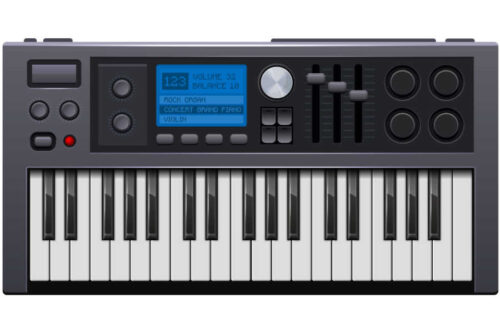Surprisingly, important advancements in synthesizer technology started as early as 1896 with the invention of a number of different instruments including the Telharmonium, Theremin, Ondes Martenot, and Electronic Sackbut. These early synthesizers allowed for more creativity and expression in music, which would pave the way for future generations of musicians.
The first commercially accessible synthesizer wasn't created until 1970, when Bob Moog (pronounced "vogue") released the Minimoog. This was a massive shift in the world of music, as it allowed anyone with the right tools to create any sound they could imagine. Prior to this, synthesizers were incredibly expensive and only available to those with a lot of money or connections. Since then, we've been absolutely hooked on synthesizers. Their versatility in creating new and unique sounds has made them an integral and essential element of today's pop and alternative music scenes. Without synthesizers, the music of today would be drastically different - and in our opinion, not nearly as interesting or exciting.
There is something about synthesizers that has captured the imaginations of musicians for decades, and this fascination persists even in the modern digital age. With just a few clicks, anyone can access a wide range of synthesizers online. Whether it's the simple charms of early analog machines or the seemingly unlimited possibilities of modern digital devices, there is something about these instruments that continue to inspire musicians around the world.
Many producers rely on virtual instruments or presets to create the sounds they want for their music. However, those who can take the time to learn how to use synthesizers have a much greater range of options and can create truly unique sounds. If you're willing to put in the effort to learn, understanding and manipulating synthesizers can be a hugely rewarding experience. We'll go through the fundamentals of synthesis, covering both hardware and software synthesizers, with a heavier emphasis on the latter. As we go along, we'll provide helpful hints to make the learning process easier.
What is a synthesizer?
Before we can understand how synthesizers work, it is crucial that we first understand how our ears work. The ambient atmosphere also vibrates in response to an object's vibration. Our ears pick up on these fluctuations and interpret them as sound signals for our brain. In other words, sound is created when something vibrates in the surrounding air, and we hear that sound because our ears are able to detect those vibrations. Synthesizers work by using these same principles to create their own sounds.
A synth uses an electrical signal to simulate the vibration of a string or voice chord, allowing for tempo and pitch manipulations that are impossible with actual acoustic sounds. These electrical signals are eventually amplified and broadcast through a speaker, where they cause audible vibrations in the air. This process allows us to hear sounds.
Every synthesizer has a handful of standard controls that may be adjusted by the user to alter the sound being generated. The term "patch" is used to describe the sum of these individual adjustments to various parameters, including things like oscillator shape, filter cutoff, and envelope settings. By creating different patches, synth users can create a wide range of sounds for their music.
Oscillators
To create a synthetic tone, oscillators (or voltage-controlled oscillators) are used. Their output is a repeating waveform that may be altered using three major knobs: the frequency knob, which determines the note being played; the amplitude knob, which adjusts how loud the note is; and the waveshape knob, which changes the basic shape of the waveform.
Oscillators are the core tone-generating engines in most synthesizers, and they usually come with at least two channels. These channels can be stacked on top of each other to create new and interesting sounds. To get the most out of this stacking capability, each oscillator should be tuned to an octave, a semitone, and a cent (one hundredth of a semitone). This concept of building blocks is known as additive synthesis.
The Low Frequency Oscillator, or LFO, is an additional oscillator that can be used to modify the synth's other parameters without altering the sound's pitch. This makes it a powerful tool for creating a wide range of sounds and effects. Its frequency of vibration is so low that it is imperceptible to the human ear. Like a main oscillator, an LFO's rate may be changed. The most common use for an LFO is to modulate another parameter of a sound-producing device, such as pitch or amplitude.
Filters
Oscillator output, like that of any acoustic instrument, consists of a fundamental frequency (the lowest frequency generated by an oscillation, which corresponds to the note played; for example, 440 Hz = A4 on a synth) and a succession of higher frequencies, called harmonics. These harmonics are multiples of the fundamental frequency, with each harmonic sounding successively higher in pitch than the last. The combination of these various frequencies results in the characteristic timbre of the instrument.
Rich, warm, and noisy are just a few of the words that can be used to characterize timbre. Timbre consists of the tonal characteristics or colors that make one sound distinctive from another and is separate from pitch and loudness. In other words, it's what makes a particular sound unique.
The filter is a sound-processing component that receives a signal from an oscillator and modifies its harmonic characteristics. The four most typical options for filters are low-pass, high-pass, bandpass, and notch. Low-pass filters allow low frequencies through and block high frequencies. High-pass filters do the reverse, allowing high frequencies through and blocking low frequencies. Bandpass filters pass a range of frequencies in the middle while blocking both lower and higher frequencies. Notch filters block a specific range of frequencies while allowing all others to pass through.
One of the most basic ways to shape a waveform is to open and close a filter. This enables high-frequency information to get through, creating a more dazzling sound. Closing the filter again filters out this information, resulting in a mellower sound. Subtractive synthesis is a technique used to create sounds by starting with complex waveforms and then using filters to remove certain frequencies. This technique was popular in early analog synthesizers, and is still used today in Reason's Subtractor synth. By starting with rich, full-sounding waveforms and then sculpting them with filters, subtractive synthesis can create a wide range of sounds, from warm and mellow to bright and piercing.
The filter's resonance parameter amplifies the frequencies surrounding the cutoff point, resulting in a ringing sound. This is especially noticeable when used with an LFO, as it creates the signature filter sweep sound. However, you should be cautious when increasing the resonance, as too much of it can cause an unpleasant shrillness in the sound.
Amplifiers and envelopes
After a signal has been filtered, it is then sent to an amplifier or voltage-controlled amplifier (VCA) in order to be amplified. This amplifies the signal so that it can be properly processed and analyzed.
Envelopes, also known as ADSR filters, are affixed to amplifiers and regulate the time-varying volume via a four-stage process. When a key is hit, these four steps determine the course of the synthesizer's output. The first stage, Attack, determines how quickly the sound reaches its maximum volume. The Decay stage then follows, during which the sound's volume decreases to a designated Sustain level. After the key is released, the Release stage kicks in, during which the sound fades away until it finally reaches silence.
Modulation
Modulation is a term used to describe the process of changing or altering something. In synthesis, modulation refers to the act of changing one or more parameters of a sound-generating patch in order to create new timbres and textures. The most common type of modulation is pitch modulation, which simply entails varying the pitch of a sound over time. However, other types of synthesis modules can also be modulated, including oscillators, filters, and amplifiers. By modulating these different aspects of a sound, it's possible to create an incredibly wide range of sonic effects, from simple vibrato and tremolo to complex waveforms and digital noise.
Conclusion
You have probably realized by now that there is a lot of information to absorb in regards to synthesizers. Just by introducing you to some important parameters, synth kinds, and modulation fundamentals, this article only scratches the surface. There is still much more to learn if you want to become an expert in synthesis. However, don't be discouraged - even small steps can lead you closer towards your goal. Start by practicing what you have learned from this article, and before long, you will be making incredible music with synthesizers!
Harlan Kilstein began playing piano during covid with no piano background at all. He taught himself how to play learning what to do and what not to do.
Today he's an advanced intermediate player and can help you grow in your skills because he learned all this on his own.







